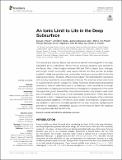Files in this item
An ionic limit to life in the deep subsurface
Item metadata
| dc.contributor.author | Payler, Samuel J. | |
| dc.contributor.author | Biddle, Jennifer F. | |
| dc.contributor.author | Sherwood Lollar, Barbara | |
| dc.contributor.author | Fox-Powell, Mark G. | |
| dc.contributor.author | Edwards, Thomas | |
| dc.contributor.author | Ngwenya, Bryne T. | |
| dc.contributor.author | Paling, Sean M. | |
| dc.contributor.author | Cockell, Charles S. | |
| dc.date.accessioned | 2019-03-22T11:30:07Z | |
| dc.date.available | 2019-03-22T11:30:07Z | |
| dc.date.issued | 2019-03-12 | |
| dc.identifier | 258270099 | |
| dc.identifier | a526b5c3-a09d-4f6f-94ff-9ac4ea845257 | |
| dc.identifier | 85066467986 | |
| dc.identifier | 000460967400003 | |
| dc.identifier.citation | Payler , S J , Biddle , J F , Sherwood Lollar , B , Fox-Powell , M G , Edwards , T , Ngwenya , B T , Paling , S M & Cockell , C S 2019 , ' An ionic limit to life in the deep subsurface ' , Frontiers in Microbiology , vol. 10 , 00426 . https://doi.org/10.3389/fmicb.2019.00426 | en |
| dc.identifier.issn | 1664-302X | |
| dc.identifier.other | crossref: 10.3389/fmicb.2019.00426 | |
| dc.identifier.uri | https://hdl.handle.net/10023/17343 | |
| dc.description | SP was supported by EPSRC. We would also like to acknowledge the Deep Carbon Observatory for partly funding the metagenome sequencing and Natural Sciences and Engineering Council of Canada (NSERC) funding to BS Lollar for funding the fluid isotope work (Discovery Grant No. 453949). | en |
| dc.description.abstract | The physical and chemical factors that can limit or prevent microbial growth in the deep subsurface are not well defined. Brines from an evaporite sequence were sampled in the Boulby Mine, United Kingdom between 800 and 1300 m depth. Ionic, hydrogen and oxygen isotopic composition were used to identify two brine sources, an aquifer situated in strata overlying the mine, and another ambiguous source distinct from the regional groundwater. The ability of the brines to support microbial replication was tested with culturing experiments using a diversity of inocula. The examined brines were found to be permissive for growth, except one. Testing this brine’s physicochemical properties showed it to have low water activity and to be chaotropic, which we attribute to the high concentration of magnesium and chloride ions. Metagenomic sequencing of the brines that supported growth showed their microbial communities to be similar to each other and comparable to those found in other hypersaline environments. These data show that solutions high in dissolved ions can shape the microbial diversity of the continental deep subsurface biosphere. Furthermore, under certain circumstances, complex brines can establish a hard limit to microbial replication in the deep biosphere, highlighting the potential for subsurface uninhabitable aqueous environments at depths far shallower than a geothermally-defined limit to life. | |
| dc.format.extent | 15 | |
| dc.format.extent | 9275280 | |
| dc.language.iso | eng | |
| dc.relation.ispartof | Frontiers in Microbiology | en |
| dc.subject | Evaporite | en |
| dc.subject | Salt | en |
| dc.subject | Habitability | en |
| dc.subject | Astrobiology | en |
| dc.subject | Subsurface | en |
| dc.subject | GE Environmental Sciences | en |
| dc.subject | DAS | en |
| dc.subject.lcc | GE | en |
| dc.title | An ionic limit to life in the deep subsurface | en |
| dc.type | Journal article | en |
| dc.contributor.institution | University of St Andrews. School of Earth & Environmental Sciences | en |
| dc.contributor.institution | University of St Andrews. St Andrews Centre for Exoplanet Science | en |
| dc.identifier.doi | 10.3389/fmicb.2019.00426 | |
| dc.description.status | Peer reviewed | en |
This item appears in the following Collection(s)
Items in the St Andrews Research Repository are protected by copyright, with all rights reserved, unless otherwise indicated.

